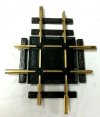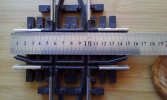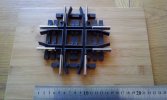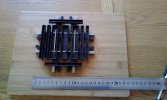You are using an out of date browser. It may not display this or other websites correctly.
You should upgrade or use an alternative browser.
You should upgrade or use an alternative browser.
wagon turntable
- Thread starter Paul2727
- Start date
ebay mike
Retired, but still hoarding. (GOF)
How long do you intend the tracks to be? Don't forget the crossing geometry isn't symmetrical - one 'leg' is shorter than the other three.Hi all,
I'm thinking about building a couple of wagon turntables from LGB 90 degree crossings. Has any build a wagon turntable in 45mm? Also how were the capstans placed?
Regards,
Paul.
musket the dog
Registered
It might not come with the same sense of accomplishment as making your own from the LGB crossings but Swift Sixteen sell a resin kit to make one. I don't own one of the turn tables, but I've had a few pieces off of Swift Sixteen and the mouldings have always been of excellent quality and very robust.
Wagon Turntable
As for the Capstans, would it be one at the end of each siding you intend to draw the wagon in to, and its opposite on the other side of the turn table but with enough clearance to drive a wagon past?
Wagon Turntable
As for the Capstans, would it be one at the end of each siding you intend to draw the wagon in to, and its opposite on the other side of the turn table but with enough clearance to drive a wagon past?
Paul2727
Registered
Basically to take a feldbahn sized wagon. So all the legs would be cut down to fit within a circle of that size. The remaining part of the crossing would then glued to the pivoting turntable bed and infilled where practical. A matching ring would be produced with exit / entrance tracks cut to suit.How long do you intend the tracks to be? Don't forget the crossing geometry isn't symmetrical - one 'leg' is shorter than the other three.
while most wagons were pushed manually on / off these little turntables, capstans were often used in conjunction with rope or chain to allow horses or locomotives to pull the wagons at ninety degrees to the main track.
Paul2727
Registered
A lovely looking thing, but appears to have non conductive rails. I'm hoping to be able to run track powered locos over mine.It might not come with the same sense of accomplishment as making your own from the LGB crossings but Swift Sixteen sell a resin kit to make one. I don't own one of the turn tables, but I've had a few pieces off of Swift Sixteen and the mouldings have always been of excellent quality and very robust.
Paul.
ebay mike
Retired, but still hoarding. (GOF)
Paul, I did have an Aristocraft 90° crossing, but I think it was either nickel silver or stainless steel finish. If I still have it would it be an option for you? That one had equal length tracks.A lovely looking thing, but appears to have non conductive rails. I'm hoping to be able to run track powered locos over mine.
Paul.
Gizzy
A gentleman, a scholar, and a railway modeller....
I sold one to Steve (Fun & Trains) recently, and from what I remember, the longer road had a longer base section too, so this might not be viable. I was going to cut mine down for a scissors crossing....Hi all,
I'm thinking about building a couple of wagon turntables from LGB 90 degree crossings. Has any build a wagon turntable in 45mm? Also how were the capstans placed?
Regards,
Paul.
ebay mike
Retired, but still hoarding. (GOF)
Update.Paul, I did have an Aristocraft 90° crossing, but I think it was either nickel silver or stainless steel finish. If I still have it would it be an option for you? That one had equal length tracks.
I knew I had one somewhere. Not sure if the insulated section would be too long for your purposes, but it would save you having to cut any rails. Only got one though.
Attachments
Nodrog1826
Professional Idiot
Daft suggestion, copper foil tape could be used to cover the rails and make them conductive, it's done with lego plastic RC track to convert it to the 9v version.A lovely looking thing, but appears to have non conductive rails. I'm hoping to be able to run track powered locos over mine.
Paul.
Paul2727
Registered
Thanks Mike,Update.
I knew I had one somewhere. Not sure if the insulated section would be too long for your purposes, but it would save you having to cut any rails. Only got one though.
That's a nice crossing. However the inner 'rails' on the Aristo ones are non conductive as opposed to the LGB ones. (Which I have several of.)
This may be a problem for my short wheelbase 0-4-0 track powered locos.
Track cutting is not a problem as I have some very good hss hole cutters upto 30 m which use a central drill for location.
It should be just a case of mounting the crossing onto a suitable board, clamping another identical board underneath, drilling a centre through them all and then following through with the hole cutter. In theory this should leave me with a turntable base an outer ring and all rail ends with a gap the thickness of the cutting blade (1 mm.)
It all depends how they are connected electrically if I'll have to rewire the crossing.
That said I shall keep your offer in mind, if the LGB ones turn out to be unsuitable.
Regards,
Paul.

Copper tape is a great resource and should be perfectly adequate for low use locations. It is also great for running wires in the i sides of buildings to solder bulbs of Leds to. Available at some Model Shops but you will always find it in a Dolls House Shop.Daft suggestion, copper foil tape could be used to cover the rails and make them conductive, it's done with lego plastic RC track to convert it to the 9v version.
Northsider
Modelling the Northern half of the Isle of Man
I'd have a test cut first: hole saws tend to be for use on wood, not metal. Ideally you would have three teeth in contact with the rail head (and bear in mind the web will be thinner, so you may need an even finer-toothed blade to stop it jamming in the gullet). A standard hacksaw blade is usually 18 or 24 teeth per inch, ie with approx a 1mm pitch.Thanks Mike,
That's a nice crossing. However the inner 'rails' on the Aristo ones are non conductive as opposed to the LGB ones. (Which I have several of.)
This may be a problem for my short wheelbase 0-4-0 track powered locos.
Track cutting is not a problem as I have some very good hss hole cutters upto 30 m which use a central drill for location.
It should be just a case of mounting the crossing onto a suitable board, clamping another identical board underneath, drilling a centre through them all and then following through with the hole cutter. In theory this should leave me with a turntable base an outer ring and all rail ends with a gap the thickness of the cutting blade (1 mm.)
It all depends how they are connected electrically if I'll have to rewire the crossing.
That said I shall keep your offer in mind, if the LGB ones turn out to be unsuitable.
Regards,
Paul.View attachment 271173
Rhinochugger
Retired Oik
At £20, and with it being stated as having a rail height 3mm below normal G scale track, how difficult would it be to cut out the moulded rail and insert some metal rails - even a length of code 200 (Peco) might workA lovely looking thing, but appears to have non conductive rails. I'm hoping to be able to run track powered locos over mine.
Paul.
Paul2727
Registered
I'd have a test cut first: hole saws tend to be for use on wood, not metal. Ideally you would have three teeth in contact with the rail head (and bear in mind the web will be thinner, so you may need an even finer-toothed blade to stop it jamming in the gullet). A standard hacksaw blade is usually 18 or 24 teeth per inch, ie with approx a 1mm pitch.
My Starrett Bi-Metal Hole Saws contains an extra cobalt HSS tooth material for enhanced heat and wear resistance.
Featuring 26 TPI positive rake tooth design, ensuring a smoother cut. they are designed to cut stainless steel, metals and mild steel sheet. Will also cut through wood, plastic, plaster and bone. (Don't ask about the last one
Northsider
Modelling the Northern half of the Isle of Man
26 tpi? That'll do nicely, sir!My Starrett Bi-Metal Hole Saws contains an extra cobalt HSS tooth material for enhanced heat and wear resistance.
Featuring 26 TPI positive rake tooth design, ensuring a smoother cut. they are designed to cut stainless steel, metals and mild steel sheet. Will also cut through wood, plastic, plaster and bone. (Don't ask about the last one!)



